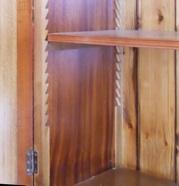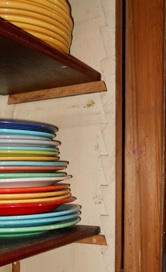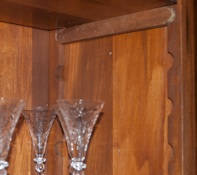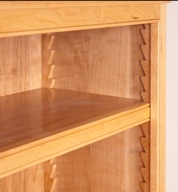 For as long as carpenters have been making cabinets they have been
searching for ways to increase the versatility and value of the
cabinets. One of the basic ways to achieve this is to make shelves
adjustable. Many methods have been used over hundreds of years to
implement this simple feature.
For as long as carpenters have been making cabinets they have been
searching for ways to increase the versatility and value of the
cabinets. One of the basic ways to achieve this is to make shelves
adjustable. Many methods have been used over hundreds of years to
implement this simple feature.
 Prior to the industrial revolution, the most common method used to
make shelves adjustable was the "sawtooth" method, also
known as "ratchet" or "bird's mouth" shelving.
This method uses an angle and flat cut into a side support with a
cleat to support the shelf. There were as many versions of the basic
design as there were craftsmen who cut each angle by hand. This is
clear when looking at period cabinets and furniture and noticing the
differences in the size and proportion of the supports, angles, and
cleats.
Prior to the industrial revolution, the most common method used to
make shelves adjustable was the "sawtooth" method, also
known as "ratchet" or "bird's mouth" shelving.
This method uses an angle and flat cut into a side support with a
cleat to support the shelf. There were as many versions of the basic
design as there were craftsmen who cut each angle by hand. This is
clear when looking at period cabinets and furniture and noticing the
differences in the size and proportion of the supports, angles, and
cleats.
 At the beginning of the industrial revolution a version of the wooden
shelf support that was made easier by the use of a drill to cut a half
round notch in the side support and rounding the end of the cleat to
fit grew in popularity. This method seems to be less common than the
angled supports, probably because a type of cast iron shelf pins was
introduced around the same time.
At the beginning of the industrial revolution a version of the wooden
shelf support that was made easier by the use of a drill to cut a half
round notch in the side support and rounding the end of the cleat to
fit grew in popularity. This method seems to be less common than the
angled supports, probably because a type of cast iron shelf pins was
introduced around the same time.
The steel shelf standard with clips, steel brackets, and a wide array of pins came next with many different sizes, colors, and designs. With the introduction of the 32mm cabinet system the pin became the accepted standard we know today.
 The sawtooth shelf support of the past showed a level of
detail and craftsmanship that has been lost primarily due to
labor costs, construction methods, and the fact that the cut is
difficult to be made by machine. Now with Sawtooth™
Shelf System it is possible the recreate the detail and
workmanship of the past with correct proportions in a cost effective
manner. Details like the Sawtooth™ Shelf System
are what makes fine cabinets stand apart from the others.
The sawtooth shelf support of the past showed a level of
detail and craftsmanship that has been lost primarily due to
labor costs, construction methods, and the fact that the cut is
difficult to be made by machine. Now with Sawtooth™
Shelf System it is possible the recreate the detail and
workmanship of the past with correct proportions in a cost effective
manner. Details like the Sawtooth™ Shelf System
are what makes fine cabinets stand apart from the others.
